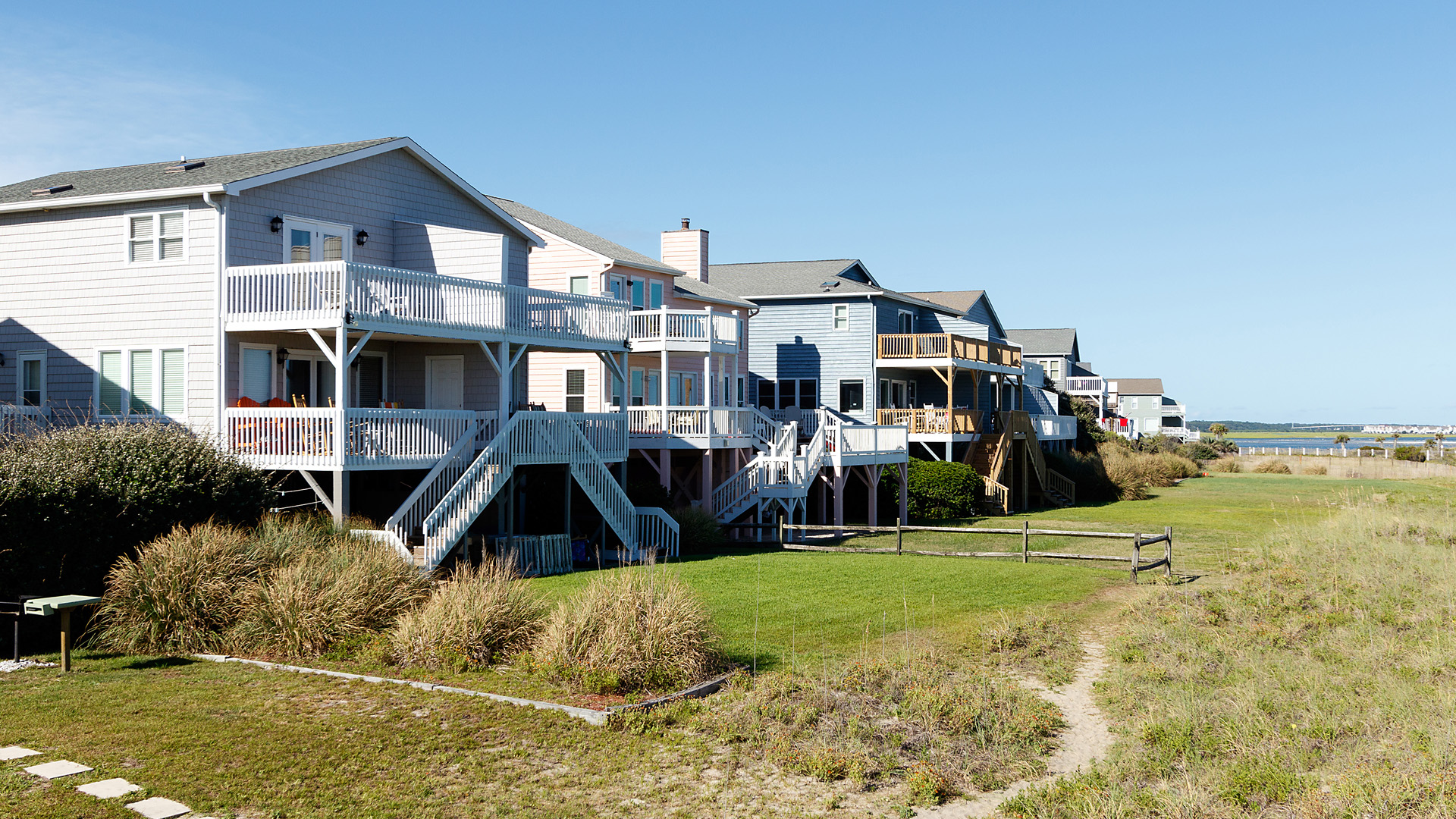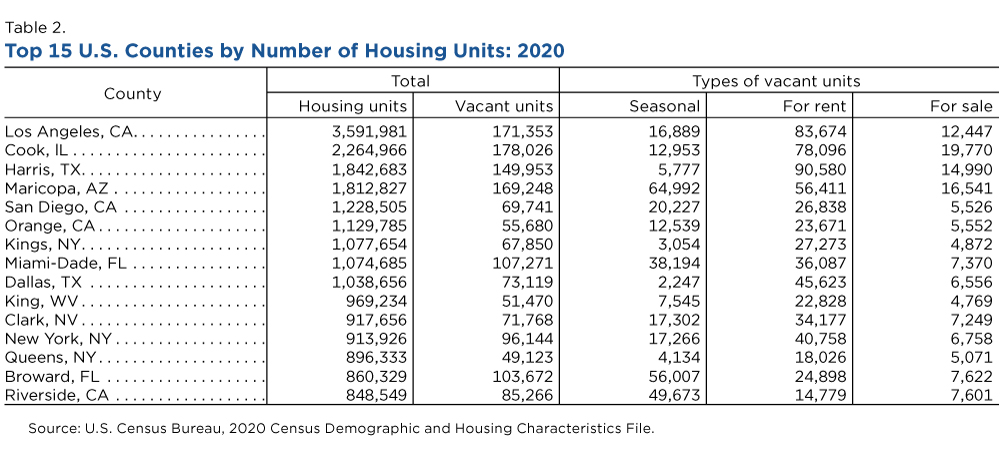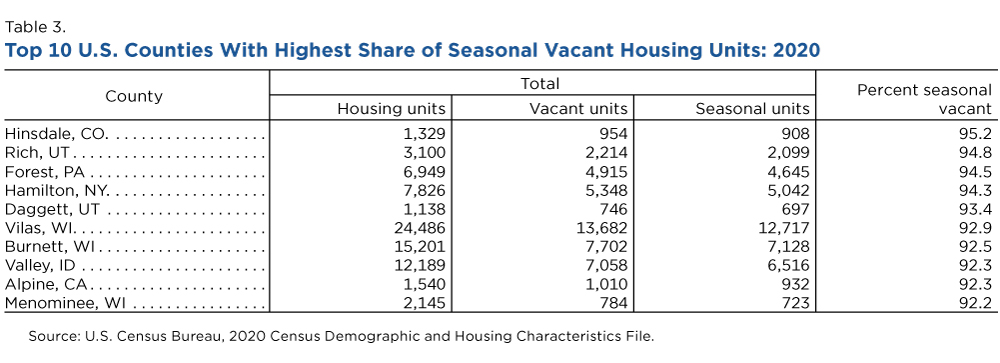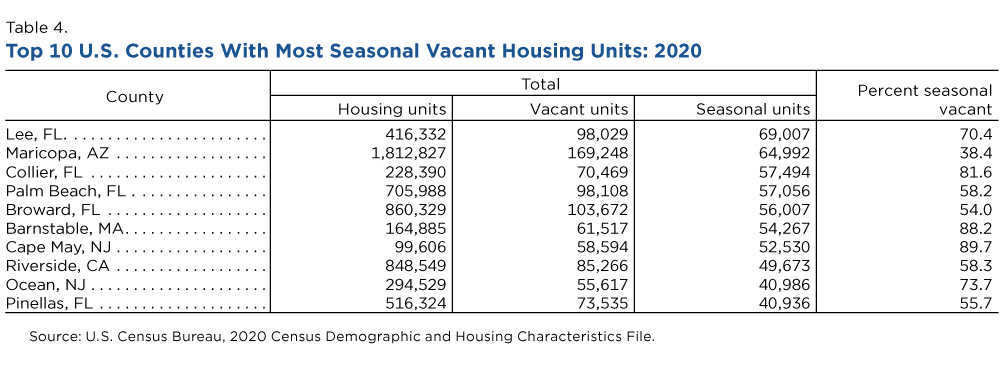Most U.S. Vacant Housing Is Seasonal Housing
When many people think of vacant homes, they think of houses or apartments on the market for sale or rent. But the largest category of vacant housing in the United States is classified as “seasonal, recreational or occasional use,” commonly referred to as seasonal units.
These vacant structures cover a wide range of housing units, from part-time residences and hunting cabins to beach houses and timeshares.
As the nation recovered from the 2007-2008 housing crisis, the vacancy rate decreased from 11.4% in 2010 to 9.7% in 2020, according to 2020 Census Demographic and Housing Characteristics data released today.
In 645 of the nation’s 3,143 counties, seasonal units made up at least 50% of the vacant housing in the county. In 1,313 counties, seasonal units outnumbered the combined total number of units for rent or sale that were vacant.
The number of units for rent, units for sale, seasonal units and units that were in the vacant for some other reason category all declined during this period.
Despite that decline, there were still over 4.3 million vacant seasonal units throughout the country and seasonal units were once again the largest category of vacant housing (Table 1).
The term “seasonal vacant” covers a wide swath of potential situations, so it’s not surprising such vacancies were found in every county in the country.
But while everywhere, seasonal vacants were more common in certain places.
In 645 of the nation’s 3,143 counties, seasonal units made up at least 50% of the vacant housing in the county. In 1,313 counties, seasonal units outnumbered the combined total number of units for rent or sale that were vacant.
While these counties included areas typically known as vacation or second-home destinations, they also included some of the country’s most populous areas.
Among the 15 largest counties by number of housing units, 11 had many more vacant units listed for rent than for any other vacant category, including New York County, New York; Harris County, Texas; Cook County, Illinois; and Los Angeles County, California (Table 2).
However, Riverside County, California; Broward County and Miami-Dade County, Florida; and Maricopa County, Arizona, had more vacant units that were for seasonal, recreational or occasional use than vacant units for rent or for sale.
There were also 20 counties where over 90% of the vacant units were seasonal, including six in Wisconsin (Vilas, Burnett, Menominee, Florence, Sawyer, Oneida counties) and three in Colorado (Hinsdale, Mineral and Grand counties) (Table 3).
All 20 of these counties also had vacancy rates much higher than the national rate of 9.7%; all but six had a vacancy rate over 50%.
The counties with the largest total number of seasonal units were in seasonal destinations, such as beach towns and ski resort areas.
Five of the top 10 counties were in Florida and two others were in New Jersey. Maricopa County and Riverside County were the only counties in the top 10 not located along a coast (Table 4).
Despite the name, seasonal units cover a wide range of housing, including part-time snowbird housing in Maricopa County; second homes in New York County; hunting cabins in Vilas County, Wisconsin; and beach houses in Cape May County, New Jersey.
While it might seem complicated, the Census Bureau provides guidance to determine if a housing unit is vacant and, if so, how it should be classified.
The decennial census is the primary source of information on the type of vacant housing in your neighborhood but it’s not the only one. The Census Bureau’s Housing Vacancy Survey and American Community Survey monitor trends in vacant housing on a more frequent basis.
Related Statistics
Subscribe
Our email newsletter is sent out on the day we publish a story. Get an alert directly in your inbox to read, share and blog about our newest stories.
Contact our Public Information Office for media inquiries or interviews.
-
America Counts Story2020 Census: 1 in 6 People in the United States Were 65 and OverMay 25, 2023The U.S. population age 65 and over grew from 2010 to 2020 at fastest rate since 1880 to 1890 and reached 55.8 million, a 38.6% increase in just 10 years.
-
America Counts StoryHispanic Population is Younger But Aging FasterMay 25, 2023The Hispanic population was younger than the non-Hispanic population in 2020 and accounted for a quarter of all children under 18 in the United States.
-
America Counts StoryShare of U.S. Coupled Households Declined in 2020May 25, 2023Coupled households still made up more than half of all U.S. households but their share dropped since 2000.
-
EmploymentThe Stories Behind Census Numbers in 2025December 22, 2025A year-end review of America Counts stories on everything from families and housing to business and income.
-
Families and Living ArrangementsMore First-Time Moms Live With an Unmarried PartnerDecember 16, 2025About a quarter of all first-time mothers were cohabiting at the time of childbirth in the early 2020s. College-educated moms were more likely to be married.
-
Business and EconomyState Governments Parlay Sports Betting Into Tax WindfallDecember 10, 2025Total state-level sports betting tax revenues has increased 382% since the third quarter of 2021, when data collection began.
-
EmploymentU.S. Workforce is Aging, Especially in Some FirmsDecember 02, 2025Firms in sectors like utilities and manufacturing and states like Maine are more likely to have a high share of workers over age 55.








